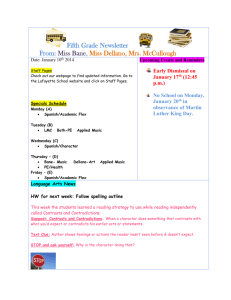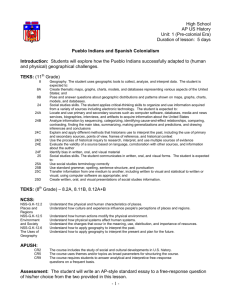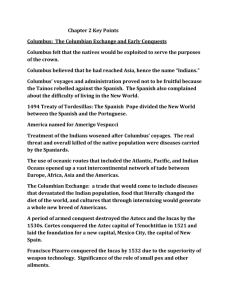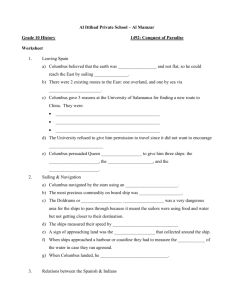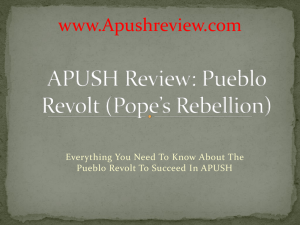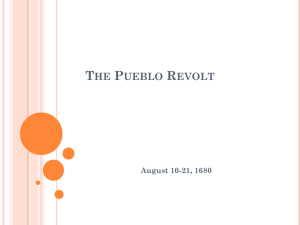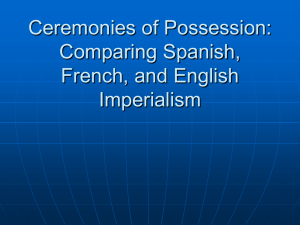Period 1 1491
advertisement
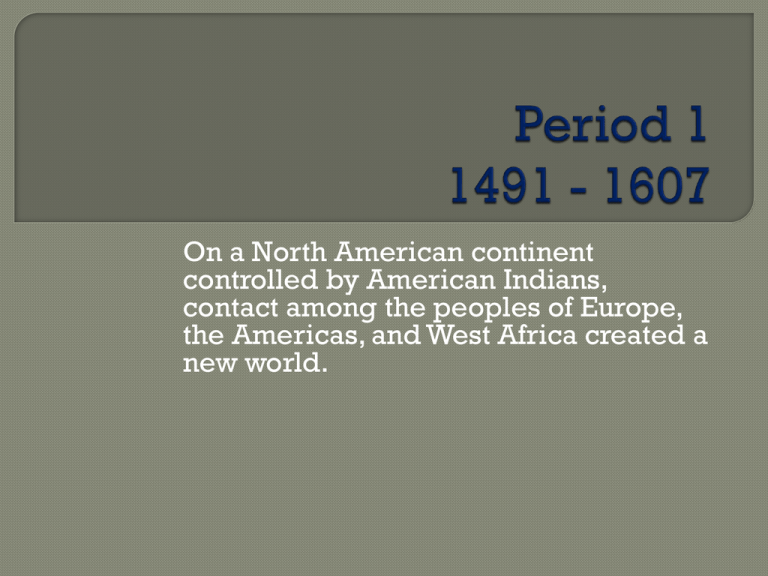
On a North American continent controlled by American Indians, contact among the peoples of Europe, the Americas, and West Africa created a new world. oBefore the arrival of Europeans, native populations in North America developed a wide variety of: osocial opolitical and oeconomic structures based in part on interactions with the environment and each other. Southwest • dry, arid climate • Hohokam, Anasazi, Pueblo multifaceted societies farmed with irrigation constructed/lived in caves, under cliffs, multistoried buildings Northwest • Pacific coast, Alaska to California longhouses Northwest • hunting, fishing, gathering nuts, roots, berries • isolated by mountains hindered trade, development • carved totem poles to preserve stories, legends, myths Great Plains • nomadic hunters buffalo lived in tepees • sedentary farmers & traders raised corn (maize), beans, squash lived in earthen lodges along rivers • migration movement of people within an area/country Midwest Settlements • Woodland American Indians hunted, fished, farmed • Adena-Hopewell large earthen mounds present day Ohio • Cahokia 30,000 inhabitants present day East St. Louis Northeast Settlements • hunted & farmed • Iroquois Confederation political union of 5 tribes Seneca, Cayuga, Onondaga, Oneida, Mohawk • matrilineal heritage families organized through female lineage’s • lived in longhouses Atlantic Seaboard Settlements Coastal Plains from New Jersey to Florida built timber & bark lodgings along rivers rivers & Atlantic Ocean utilized for food oEuropean overseas expansion resulted in the: oColumbian Exchange oa series of interactions and adaptations among societies across the Atlantic Widespread deadly epidemics • small pox, measles, influenza Racially mixed populations • mestizo, mulatto Caste system • based upon intermixture of Spanish settlers, Africans, and indigenous Native Americans Spanish/Portuguese Africa traders reach West • trade for resources, slaves • Prince Henry the Navigator New crops, livestock introduced to New World • Columbian Exchange • sugar cane, bluegrasses, pigs, horses, cows • the wheel, iron implements, guns Encomienda System • slave labor used in New World Spanish colonies • vast tracts of land AND, the indigenous people living there, given to the Spanish lord/conquistador, who promises to uplift and Christianize them! • slavery by any other name often brutalized, exploited in sugar fields, silver mines Causes of European expansion: • The 3 G’s Gold, God, Glory New crops from the America’s fuel population growth • Columbian Exchange beans, corn (maize), sweet/white potatoes, tomatoes, tobacco, New sources of wealth • gold, silver fuel shift from feudalism to capitalism Improvements in technology and trade • arms • social technology bureaucracy, double-entry bookkeeping, mechanical printing • amassing wealth/dominating people positively valued on Earth and towards salvation (Lies, p.33) • nature of European Christianity rationalized conquest “the Requirement” (Lies, p. 34) Improvements in technology and trade • European success in island conquests Malta, Sardinia, Canary Islands, Ireland, etc… a route to wealth • caravel • sextant • joint-stock companies precursor to corporation oContacts among American Indians, Africans, and Europeans challenged the worldviews of each group. Contact with people different from themselves caused debates • comparisons of nature and degrees of civility Juan de Sepulveda Bartolome de Las Casas • ethnocentrism belief that one’s own culture and way of life is best, superior to all others common among all human cultures belief in white superiority evolves Politically, • challenged European ideas of government, social organization “Lies”, pp. 57-58 Religiously, • challenged Europe’s uniformity leads to Protestant Reformation • established “mission system” presidio fort & mission to protect selves and Christianize natives Forms of resistance - Native Americans: • refused to plant food • abandoned towns near Spanish settlements • fled beyond mountains and rivers • suicide • shunned conception & childbirth • aborted • murdered their children • slave revolts Forms of resistance – African Americans: • run away to Native American communities • slave revolts New York City – 1712 21 blacks executed over a slow fire Stono Rebellion – 1739 South Carolina 21 whites and 44 blacks killed Juan de Onate • Spanish conquistador • attempted to spread Catholicism among natives of New Mexico Acoma War - 1598 • 800 villagers, including men, women, and children killed • enslaved the remaining 500 • they amputated the left foot of every Acoma man over the age of twenty-five • females sent off to be slaves for twenty years Pope’s Rebellion -1680 • also known as the Pueblo Revolt • an uprising of Pueblo Indians against the Spanish colonizers in present day New Mexico • the Pueblo killed 400 Spanish and drove the remaining 2,000 settlers out of the province Gullah • blend of English & several African languages spoken by blacks in South Carolina & Georgia Ring Shout • West African religious dance contributed to development of jazz Maroon communities • runaway black slaves who formed their own communities • Caribbean Islands & South America





